ANAL FISSURES
What is an Anal Fissure?
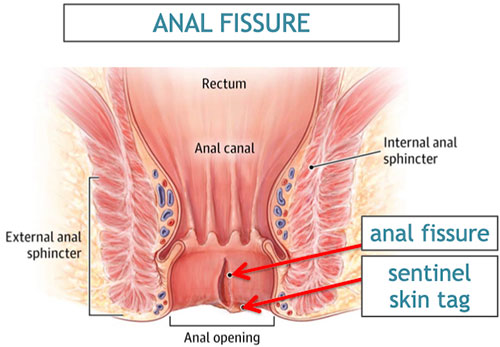
Anal fissure is a wound or a “cut” at the anus. Anal fissures may be simple or multiple, and may be noted suddenly or slowly, over time. Anal fissures are a common disease and can be a persisting nuisance if left untreated.
Anal fissures are commonly associated with a sentinel pile/tag, which is a skin tag at the edge of the fissure. These itself can be painful at times.
How do anal fissures occur?
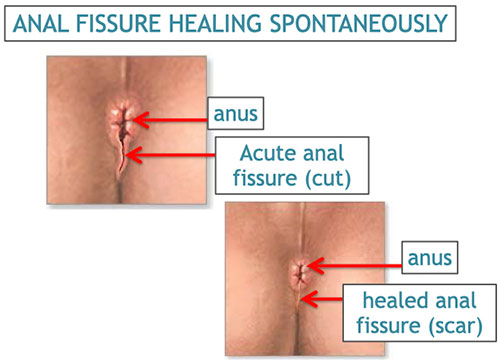
With constipation, a hard bowel movement can erode the lining in the anal canal, resulting in a shallow wound at the anal verge. This injury can then recur with every bowel movement, not allowing the wound to heal due to recurrent stretching of the area. Due to pain, the pressure in the anal canal increases as a reflex. This can further exacerbate the disease.
- straining to have a bowel movement when you are constipated
- waiting too long to have a bowel movement
- having less fibre in diet
- insufficient water intake
- sitting for a long while.
Fissures may also develop from:
- diarrhea
- poor eating habits/ starvation
- injury to the anus, for example, from anal intercourse
- dehydration
Fissures naturally tend to heal by forming a thin scar, which may tear away with a hard bowel movement. It is therefore important to understand that fissures may recur especially when they heal spontaneously.
What are the symptoms of anal fissures?

Symptoms of fissures include:
- pain during after bowel movements, which can be severe
- burning sensation in the anal region
- itching, mild burning, and bleeding around the anus (for example, you might see few drops of bright red blood on toilet paper after wiping)
- a skin tag or swelling felt at the anus (in case of sentinel pile), which may or may not be painful.
How are anal fissures diagnosed?
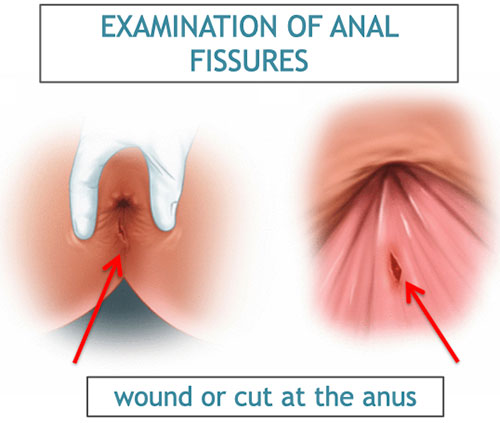
Your health care provider will examine your rectum and anus. It may be a little painful if there is a fissure.
What is the treatment of anal fissures?
Anal figures can be treated by either one or a combination of the following methods:
- Diet and lifestyle modification: high fibre diet, fluids, sitz bath and cold packs etc.
- Medications: local creams, oral medications etc.
- Non-surgical procedures: rubber band ligation, injection sclerotherapy etc.
- Surgery: Lasers ablation, arterial ligation, conventional or stapled hemorrhoid surgery etc.
What are the diet and lifestyle modifications for treatment of anal fissures?
It is recommended to eat more high-fibre foods, which will help prevent constipation. Good sources of fibre include fresh fruit, raw or cooked vegetables, especially asparagus, cabbage, carrots, corn, and broccoli, and whole-grain cereals with bran, such as shredded wheat or bran flakes. Drink plenty of water. This helps to soften stools so they are easier to pass. Regular exercise and sleep patterns also helps constipation. It is important to follow the urge of defecation and avoid straining or sitting for too long during defecation. Avoiding junk and processed foods, flour, alcohol, spices, caffeine etc as much as possible definitely helps regular bowel movements. Sitz bath (sitting in lukewarm water) 2 or 3 times a day for 15 minutes cleans the anal area and may relieve discomfort. Also, you might try putting a cloth-covered ice pack on the anus for 10 minutes, 4 times a day.
What is the medical treatment of anal fissures?
For mild discomfort, your health care provider may prescribe a cream or ointment for the painful area. Your provider may also prescribe medicated suppositories to put inside the rectum. In case of bleeding, inflamed skin tags or anal spasm, you may need oral medications as well. Constipation may need stool softeners, fibre supplements, mild laxatives etc.
What are the surgical options for treatment of anal fissures?
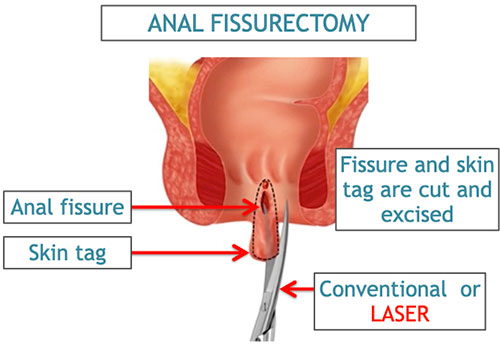
A number of procedures can be used to remove or treat fissures. The part of the anal lining which has the fissure is removed one layer deep, so that the new lining heals in a healthy way. This procedure is called fissurectomy. It not only facilitates quicker healing, but also reduces the likelihood of the same site breaking down again.
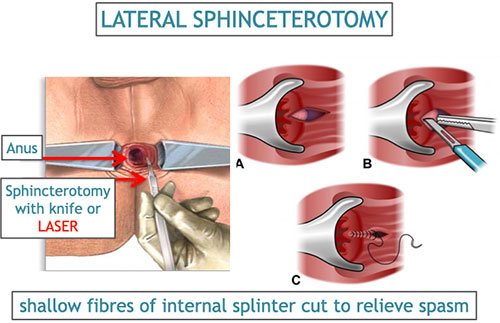
An internal anal sphicterotomy (release of few muscle fibres to relax the opening) is also done to tackle the incriminating anal sphincter spasm and prevent fissures in the future. Nowadays, most of these conventional surgeries can now be done using advanced Laser techniques.
Laser Fissurectomy and Laser Sphincterotomy offer the added benefits of minimal bleeding and pain, and a quicker recovery.
How can I take care of myself from anal fissures?
Always tell your health care provider when you have rectal bleeding. Although bleeding may result from hemorrhoids, more serious illnesses, such as colon cancer, can also cause bleeding.
Follow these guidelines to help prevent hemorrhoids and to relieve their discomfort:
- Do not strain during bowel movements. The straining makes hemorrhoids swell.
- Follow your high-fibre diet and drink plenty of water. If necessary, take a stool softener. Softer stools make it easier to empty the bowels and reduce pressure on the veins.
- Don't overuse laxatives. Diarrhea can be as irritating to the anus as constipation.
- Ask your health care provider what non-prescription product you should buy to relieve pain and itching. Also, ask about any side effects of any medications prescribed for you.
- Exercise regularly to help prevent constipation.
- Avoid a lot of wiping after a bowel movement if you have hemorrhoids. The best option to clean the area is water. If not available, wiping with soft, moist toilet paper (or a commercial moist pad or baby wipe) may relieve discomfort.